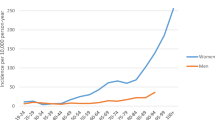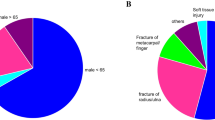Abstract
Summary
Carpal fractures were identified by the Geelong Osteoporosis Study Fracture Grid for 2006–2007. Incidence rates were higher in males than females. Males had a lower median age of fracture than females. Females had more fractures on the left side than males. Most fractures were the result of a fall.
Purpose
In this study, we report the incidence of carpal bone fractures (scaphoid and non-scaphoid) amongst residents from the Barwon Statistical Division over 2 years.
Methods
X-ray reports from imaging centres in the region were used to identify incident fractures during 2006 and 2007. Data were collected as part of the Geelong Osteoporosis Study Fracture Grid.
Results
During 2006 and 2007, there were 171 and 41 carpal fractures in males and females, respectively. Of these, 131 males and 29 females had fractured the scaphoid bone. Females had a higher proportion of left-sided fractures (>70 %) than males (∼40 %). Most fractures were the result of an accidental fall (>87 %). Patterns of incidence for males showed one major peak around 20–29 years. For females, peaks occurred around age 10–19 years and 70–79 years. Incidence rates for males (per 100,000 persons per year) were 54.6 (95 % confidence interval (CI) 53.6, 55.7) and 15.9 (95 % CI 15.4, 16.5) for scaphoid and non-scaphoid fractures, respectively. In females, the corresponding rates were 10.6 (95 % CI 10.2, 11.1) and 4.5 (95 % CI 4.2, 4.8).
Conclusion
Almost all fractures were the result of a fall. In males, carpal fractures were sustained mainly during early adulthood and in females during adolescence and after menopause. Incidence rates for males were higher than those in females for both scaphoid and non-scaphoid fractures.


Similar content being viewed by others
References
Laugharne E, Bhavsar D, Rajaratnam V (2013) The distribution of hand fractures: a British perspective. Eur J Plast Surg 36:367–370
Otmar R, Kotowicz MA, Brennan SL, Bucki-Smith G, Korn S, Pasco JA (2013) Personal and psychosocial impacts of clinical fracture in Men. J Mens Health 10:22–27
Pasco JA, Sanders KM, Hoekstra FM, Henry MJ, Nicholson GC, Kotowicz MA (2005) The human cost of fracture. Osteoporos Int 16:2046–2052
Holloway KL, Brennan SL, Kotowicz MA, Bucki-Smith G, Timney EN, Dobbins AG, Williams LJ, Pasco JA (2015) Prior fracture as a risk factor for future fracture in an Australian cohort. Osteoporos Int 26:629–635
Dobbins AG, Brennan SL, Williams LJ, Holloway KL, Pasco JA (2014) Adulthood fracture and quality of life: a population-based study of Australian men. J Mens Health 11:171–176
Dennis HHW, Sze ACK, Murphy D (2011) Prevalence of carpal fracture in Singapore. J Hand Surg 36:278–283
Meyer C, Chang J, Stern P, Osterman AL, Abzug JM (2013) Complications of distal radial and scaphoid fracture treatment. J Bone Joint Surg 95:1517–1526
Carpenter C, Pines J, Schuur J, Muir M, Calfee R, Raja A (2014) Adult scaphoid fracture. Acad Emerg Med 21:101–121
Tan S, Craigen M, Porter K (2009) Acute scaphoid fracture: a review. Trauma 11:221–239
Wolf JM, Dawson L, Mountcastle SB, Owens BD (2009) The incidence of scaphoid fracture in a military population. Injury 40:1316–1319
Van Tassel D, Owens B, Wolf J (2010) Incidence estimates and demographics of scaphoid fracture in the U.S. population. J Hand Surg 35:1242–1245
Brøndum V, Larsen CF, Skov O (1992) Fracture of the carpal scaphoid: frequency and distribution in a well-defined population. Eur J Radiol 15:118–122
Duckworth A, Jenkins P, Aitken S, Clement N, Court-Brown C, McQueen M (2011) Scaphoid fracture epidemiology. J Trauma 72:E41–E45
Pasco JA, Nicholson GC, Kotowicz MA (2012) Cohort profile: Geelong osteoporosis study. Int J Epidemiol 41:1565–1575
Pasco JA, Nicholson GC, Henry MJ, Kotowicz MA, Gaudry TM (1999) Identification of incident fractures: the Geelong Osteoporosis Study. Aust NZ J Med 29:203–206
Choi W, Robinovitch S (2011) Pressure distribution over the palm region during forward falls on the outstretched hands. J Biomech 44:532–539
Belsky MR, Leibman MI, Ruchelsman DE (2012) Scaphoid fracture in the elite athlete. Hand Clin 28:269–278
Buchman J (1928) Traumatic osteoporosis of the carpal bones. Ann Surg 87:892–910
Jørgsholm P, Thomsen NOB, Besjakov J, Abrahamsson S-O, Björkman A (2013) The benefit of magnetic resonance imaging for patients with posttraumatic radial wrist tenderness. J Hand Surg 38:29–33
Acknowledgments
The study was supported by the National Health and Medical Research Council (NHMRC, project 628582) Australia, the Geelong Regional Medical Foundation, Arthritis Foundation of Australia, Perpetual Trustees, and Amgen Europe (GmBH). SLB-O is supported by a NHMRC Early Career Fellowship (#1012472, 2011–14) and an Alfred Deakin Postdoctoral Fellowship (2015–16).
Conflict of interest
The study was supported by the National Health and Medical Research Council (NHMRC) Australia (project 628582), the Geelong Regional Medical Foundation, Arthritis Foundation of Australia, Perpetual Trustees, and Amgen Europe (GmBH); however, the funding bodies played no part in the design or conduct of the study, the collection, management, analysis and interpretation of the data, nor in the preparation or review of the manuscript. Sharon Brennan-Olsen is supported by a NHMRC Early Career Fellowship (#1012472, 2011–14) and an Alfred Deakin Postdoctoral Fellowship (2015–16). Kara Holloway, David Moloney, Sharon Brennan-Olsen, Mark Kotowicz, Gosia Bucki-Smith, Amelia Morse, Elizabeth Timney, Amelia Dobbins, Natalie Hyde, and Julie Pasco declare that they have no conflict of interest.
Author information
Authors and Affiliations
Corresponding author
Rights and permissions
About this article
Cite this article
Holloway, K.L., Moloney, D.J., Brennan-Olsen, S.L. et al. Carpal and scaphoid fracture incidence in south-eastern Australia: an epidemiologic study. Arch Osteoporos 10, 10 (2015). https://doi.org/10.1007/s11657-015-0215-6
Received:
Accepted:
Published:
DOI: https://doi.org/10.1007/s11657-015-0215-6




